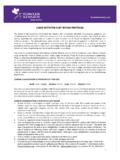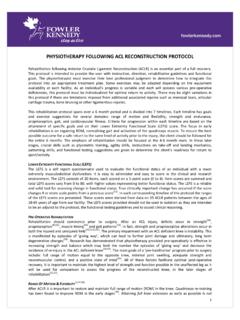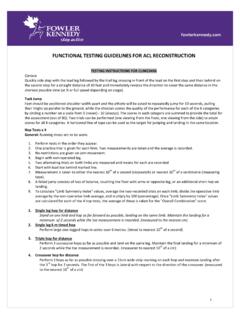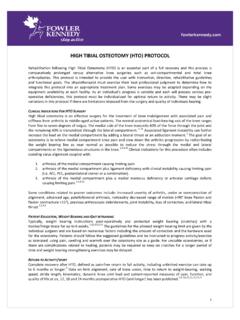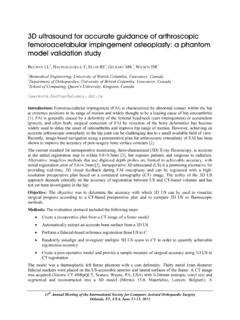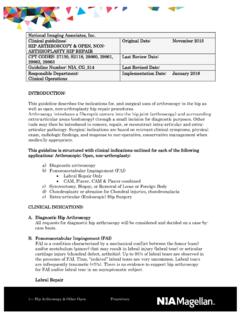Transcription of HIP ARTHROSCOPY PROTOCOL FOR FEMOROACETABULAR …
1 1 HIP ARTHROSCOPY PROTOCOL FOR FEMOROACETABULAR impingement (FAI) This PROTOCOL is intended to provide the clinician with instruction, direction, rehabilitative guidelines and functional goals for hip ARTHROSCOPY for FEMOROACETABULAR impingement (FAI) with or without a labral tear. It is not intended to be a substitute for clinical decision-making regarding the progression of a patient s post-operative course based on physical exam/findings and individual progress. The physiotherapist must exercise their best professional judgment to determine how to integrate this PROTOCOL into an appropriate treatment plan. The general treatment for a variety of hip procedures involves post operative protection for healing, stretching/mobilizing tight or restricted structures, strengthening the hip musculature and most importantly ensuring that there is adequately lumbo-pelvic stability ( core strength).
2 This PROTOCOL divided into 4 phases. Actual progress may be faster or slower depending on the individual. Decisions to advance patients through the phases of rehabilitation should be based on achieving the appropriate level of tissue healing, as well as clinical presentation and response to treatment. As an individual s progress is variable and each will possess various pre-operative deficiencies and possible pathologies, this PROTOCOL must be individualized for optimal return to activity. Some exercises may be adapted depending on the equipment availability at each facility. There may be slight variations in this PROTOCOL or additional restrictions placed by the surgeon post-operatively depending on findings at the time of the surgery. If a clinician requires assistance in treatment progression please contact the referring physician or the physiotherapy department.
3 FEMOROACETABULAR impingement FEMOROACETABULAR impingement is characterized by decreased joint clearance between the femoral head / neck and acetabulum (ball & socket). There are two described types:9 Cam impingement is defined as an abnormality of the anterolateral femoral head/neck junction Pincer impingement is described as over coverage of the acetabulum over the femoral head causing increased compressive forces between the rim of the acetabulum and the femoral head/neck. In the majority of cases (86%)11, cam and pincer forms exist together mixed impingement . With arthroscopic surgery, the anterior capsule is excised, an osteoplasty is perform for the cam impingement at the femoral head/neck junction to shave down the bony abnormality and re-create a more normal shaped femoral head.
4 Rim trimming is the procedure used with a pincer impingement to address the bony abnormality of the acetabulum. WEIGHT BEARING AND GAIT RETRAINING Weight bearing status must be adhered to based on the surgeon s orders. Most patients will be protected weight-bearing (PWB) as tolerated with crutches post-operatively. If there are additional considerations, found at the time of surgery, partial weight-bearing may be ordered based on the extent of the surgery as well as the healing properties/timelines for the involved tissue ( bone, cartilage, labral tissue, capsuloligamentous structures). 2 Patients should follow the suggested weight bearing guidelines and be instructed to progress slowly, using pain as a guide. RANGE OF MOTION (ROM) Gentle passive ROM within patient tolerance can be commenced immediately post-operatively for flexion.
5 Extension to neutral and passive internal rotation may also be initiated early post operatively with the goal of preventing joint capsule adhesions. Around the 2-week mark, abduction and external rotation can be added. Generally, a 4-6 week timeline is required to recover from the aspects of surgical intervention including intra-articular swelling. As a result, DO NOT push end ROM during this phase of healing and encourage hip ROM only to tolerance. Rehabilitative exercises should not be painful within the hip joint. STRENGTHENING EXERCISES To optimize post-operative recovery, it is important to assess and address any pre-disposing factors that may have contributed to hip pathology prior to Altered motor control strategies around the lumbar-pelvic-hip region, hip weakness and postural mal-alignment contribute to various hip pathologies.
6 A thorough assessment of the lumbar-pelvic region, hip and lower extremity is necessary and will need to be continually monitored throughout the rehab process. Generally, motor control retraining is more important than strength or power of individual muscles. Most weight bearing strengthening exercises have been show to produce significantly higher gluteal muscle activity vs. non-weight bearing exercises as there is a need for greater external torque forces on the pelvic-hip These findings relate to the weight of the leg and lever arm over coming the effect of gravity; three factors that are very important to consider with exercise progression. Post-operatively exercises will commence as ROM and non weight-bearing strengthening exercises (supine and standing).
7 Logical progression is from 2-legged weight bearing ( squats, ) to single limb ( step-ups, step-downs, single leg ). An EMG summary sheet is provided for gluteal muscle activation (GMax and GMed) levels for a variety of common therapeutic exercises given in rehabilitation from numerous articles in the QUALITY VS. COMPENSATION Physiotherapists often feel compelled to progress patients by giving them new exercises each time they are in for therapy. It cannot be stressed enough that it is not beneficial to give patients exercises they are not neuromuscularly ready for. It is very important to observe the quality of the exercises that are being performed. Weaknesses in specific muscle groups lead to compensations, which produce faulty movement patterns.
8 These faulty patterns are then integrated into unconscious motor programs, which perpetuate the original weakness. If these are allowed to occur and are not corrected, any joint or structure along the kinetic chain may be exposed to injury. RETURN TO ACTIVITY/SPORT Return to sport will depend on the individual s pre-operative level of activity/function and their ability to control the lumbar-pelvic-hip complex with dynamic single leg transfers. Returning to activities that require change of direction or speed work should be assessed on an individual basis. Gradual resumption of pain-free activities over a 3-6 month period is expected; however, actual progress may be faster or slower depending on the individual. Patients may continue to see gradual improvement in symptoms for up to one-year 3 PHASE I: 0-2 WEEKS GOALS Protect the surgical repair Patient education re: gait Protected weight-bearing (PWB): weight bearing as tolerated with crutches Ensure heel-toe patterning and pelvic alignment Minimise post-operative pain and swelling ROM goals: within tolerance EXERCISE SUGGESTIONS ROM & Flexibility Active assist supine heel slides with towel/belt +/ slider board Therapist assist or active assisted flexion, extension (to neutral), IR log/leg rolling Muscle Strength & Endurance Lumbo-Pelvic (core stability).
9 Supine Transverse abdominis (TA) and Pelvic floor setting **cueing should be specific to lifting pelvic floor and indrawing lower abdominal (effort scale for pelvic floor/abdominal contraction should be 2-4 out of 10 with normal breathing) Hip/Gluteals/Quadriceps: Isometric gluteal squeezes supine or standing Isometric abd/add supine (bent knees) Isometric quadriceps Calves: Ankle pumping and toe crunches +/ with leg elevation Gastroc/soleus stretches if needed Modalities Ice 15-25 minutes Interferential current therapy (pain relief) Game Ready 4 PHASE II: 2-6 WEEKS GOALS Patient education re: gait - Wean off crutches 2 1 none ( can be discharged from crutches when gait pattern is normalized) - Ensure heel-toe patterning and pelvic alignment ROM goals: 90 flexion and full extension by end of 6 weeks Stretching structures abound hip complex muscles, capsule Address motor control deficits around lumbo-pelvic-hip complex and transition from non-weight bearing hip ROM and strengthening to more functional closed chain exercises Baseline proprioception EXERCISE SUGGESTIONS ROM & Flexibility PROM stretches: - Hip extension / anterior capsule (Thomas stretch), prone heel to bum (Quadriceps) - IR at 0 (straight leg), 70 (supine bent knee) and prone knee bent IR - Adductors - Hip circles / circumduction Continue as needed with slider board progress to FABER heel slides as tolerated Quadruped rocking for hip flexion (pain free, ensure neutral spine) Scar / soft tissue massage.
10 Typically around TFL, ITB, GMed, Hip Flexor/upper Quadriceps Stationary bike high seat (to avoid pinching)10 Muscle Strength & Endurance Lumbo-Pelvic (core stability): Standing and sitting posture with TA and pelvic floor Basic supine TA and pelvic floor: Inner range bent knee fall outs full range **Requires activation of TA and pelvic floor to maintain centralization of the femoral head with lower extremity exercise Hip/Gluteals/Hamstrings/Quadriceps: Prone terminal hip/knee extension (pillow / foam roller under anterior ankle) Prone hip extension off edge of bed Clam shells isometric side lying hip abduction isotonic hip abduction Supine bridging: double, single, on ball Standing hip extension, abduction progress to pulleys or ankle weights (do not allow trunk shift) Quads: Isometrics, quads over roll +/ muscle stimulation or biofeedback Shuttle 2 1 leg as tolerated Sit-to-stand: high plinth, lower as tolerated Squats: wall, mini, progress to deeper squats as able Pool program (optional): Deep-water pool program if incisions are healed for: cardiovascular fitness, ROM, and hip muscle activation ( buoyancy belt in deep water: walking, cycling, hip exercises, knee/ankle ) 5 Proprioception: Weight scales: weight shifting, equal weight bearing: forward/backward and side-to-side progress to single leg weight shift with core activation and hip/pelvic control Wobble boards with support: side-to-side, forward/backward Standing on foam roller: balance rocking forward/backward Modalities Ice/IFC/Game Ready PHASE III.

